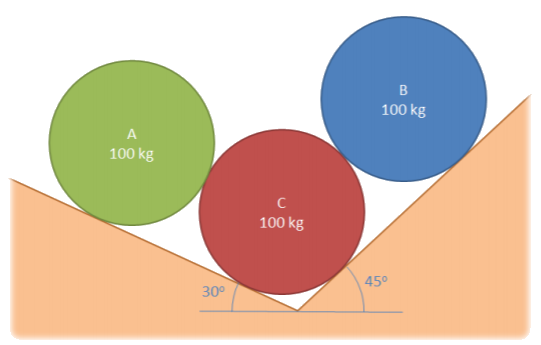2.6: Chapter 2 Homework Problems
- Page ID
- 51513
Exercise \(\PageIndex{1}\)
A 30 kg barrel is sitting on a handcart as shown below. Determine the normal forces at A and B.
.png?revision=1)
- Answer
-
\(F_A = 147.15 \, N; \, F_B = 254.87 \, N\).
Exercise \(\PageIndex{2}\)
A 0.25kg ball rolls into a corner as shown below. Assuming the surfaces are smooth (no friction), determine the normal forces at A and B.
.png?revision=1)
- Answer
-
\(F_A = 1.09 \, N; \, F_B = 3.01 \, N\)
Exercise \(\PageIndex{3}\)
A traffic light is supported by two cables as shown below. The tension in cable one is measured to be 294.8 N. What is the tension in cable two? What is the mass of the traffic light?
.png?revision=1)
- Answer
-
\(T_2 = 276.6 \, N; \, m = 20 \, kg\)
Exercise \(\PageIndex{4}\)
A 50 kg truck engine is lifted using the setup shown below. Assuming that the pulleys shown in the diagram are frictionless, what force \(P\) must be applied to the cable to hold the engine in the position shown below with \(d\) = 1 meter? (Hint: Draw a free body diagram of the pulley supporting the engine block)
.png?revision=1)
- Answer
-
\(P = 442.1 \, N\)
Exercise \(\PageIndex{5}\)
Two weights are supported via cables as shown below. If body B has a weight of 60 pounds, what is the expected weight of body A based on the angles of the cables?
.png?revision=1)
- Answer
-
\(F_{gA} = 24.89 \, lbs\)
Exercise \(\PageIndex{6}\)
Three equally sized cylinders, each with mass 100 kg, are stacked in a groove as shown below. Determine all forces acting on cylinder C and show them in a diagram.

- Answer
-
\(F_{AC} = 490.5 \, N; \, F_{BC} = 693.7 \, N; \, F_{C1} = 1304.6 \, N; \, F_{C2} = 829.7 \, N; \, F_g = 981 \, N\)
Exercise \(\PageIndex{7}\)
You are hanging a pterodactyl model from the ceiling of a museum with three cables as shown below. Assuming the pterodactyl model has a mass of 260 kg, what is the tension we would expect in each of the three cables?
.png?revision=1)
- Answer
-
\(T_A = 2306.94 \, N; \, T_B = 1393.86 \, N; \, T_C = 2569.19 \, N\)
Exercise \(\PageIndex{8}\)
A hot air balloon is tethered as shown below. Assuming that the balloon is pulling upward with a force of 900 lbs, determine the tension in each of the cables.
.png?revision=1)
- Answer
-
\(T_A = 545.5 \, lbs; \, T_B = 430.7 \, lbs; \, T_C = 320.7 \, lbs\)


